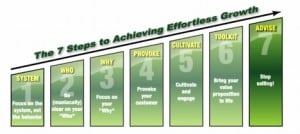
When I conduct sales training for executives and sales teams, I typically finish with the valuable thought:
"Stop Selling! If you feel like you're selling, you're doing something wrong."
I call it The Seller's Paradox.
- The more your focus is on your products, services, or (dare I say) your solutions, the less likely you'll be valued or make a sale.
- The faster you try to get to the proposal/recommendation stage in your sales process, the longer and less likely you'll be to make a sale.
- The harder you work to prove your worth, the less likely it is you'll be valued.
When you're selling (or building a go-to-market strategy) you must - must - put thoughts about yourself or your interests aside. This is the entire point of what Demand Creation Selling is all about. Traditional selling is built on a very weak foundation. Your active sales time allocation looks something like this:
- The first 20% of your time is spent on qualification, which is really a one-way check-in for the salesperson to determine if they prospect/customer is capable of buying. While surface attention is paid to needs assessment, it never goes deep to create value.
- The next 30% of the time is spent presenting, proposing and trying to convince your prospect/customer of your capabilities.
- And finally the real dance begins, as 50% (and sometimes more) of the time is spent chasing down the prospect/customer, attempting to overcome objections, negotiate and close the business.
If I had $10 for every time a salesperson or executive I was either coaching or managing said to me that they wish they knew something that came up in the last phase of the process earlier, I wouldn't need an income for several years.
However, if you go against the grain and build a solid foundation, one where you spend the first half (or more) of your time digging deep and diagnosing, you'll accelerate your sales cycle, and bypass the shop cycle 80% of the time.
Diagnosing means uncovering issues and enabling your prospect/customer to understand their situation and needs, as well as you. When taking this approach, your prospect/customer stops seeing you as a salesperson, and instead views you as a critical resource to enable them to achieve their critical objective.
When you occupy this spot in their mind, objections, hassles and delays disappear.

 Doug Davidoff
Doug Davidoff